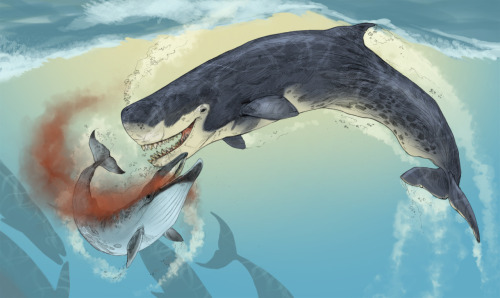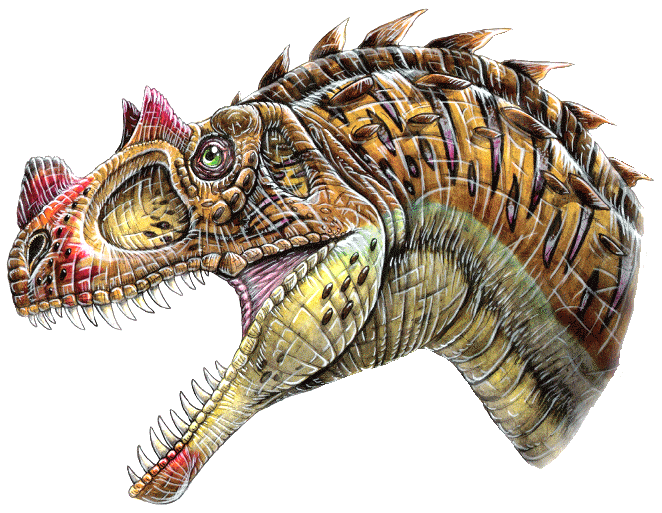Post by Canid Cetus Aves on Oct 14, 2011 17:36:24 GMT -5
Livyatan
Leviathan melvillei is an extinct species of physeteroid whale. Fossilised remains, comprising 75% of the animal's skull, and large fragments of both jaws and several teeth, were discovered in the Pisco-Ica desert in southern Peru in 2008, in Miocene rocks 12-13 million years old. The skull of Leviathan melvillei measured 3 metres long, its longest teeth were 36 cm long, and it is thought its overall length would have been in the region of 13.5-17.5 m. It was similar in size and appearance to the modern sperm whale. Unlike the sperm whale, however, which only has functional teeth in its lower jaw, Leviathan melvillei had teeth in both jaws, and is thought to have been an aggressive predator, possibly preying on baleen whales.

Megalodon
The megalodon is an extinct megatoothed shark that existed in prehistoric times, from the Oligocene to Pleistocene epochs, approximately 25 to 1.5 million years ago.
Paleontological research indicates that C. megalodon is among the largest and most powerful macro-predatory fishes in vertebrate history. C. megalodon is principally known from partially preserved skeletal remains, which indicate a shark of gigantic proportions — approaching a length of around 20.3 metres (67 ft). C. megalodon is widely regarded as the largest shark to have ever lived. After scrutiny of its remains, scientists have assigned C. megalodon to the order Lamniformes but its phylogeny is disputed. Scientists suggest that C. megalodon looked like a stockier version of the great white shark, Carcharodon carcharias, in life. Fossil evidence confirms that C. megalodon had a cosmopolitan distribution. C. megalodon was a super-predator, and bite marks on fossil bones of its victims indicate that it preyed upon large marine animals.

Leviathan melvillei is an extinct species of physeteroid whale. Fossilised remains, comprising 75% of the animal's skull, and large fragments of both jaws and several teeth, were discovered in the Pisco-Ica desert in southern Peru in 2008, in Miocene rocks 12-13 million years old. The skull of Leviathan melvillei measured 3 metres long, its longest teeth were 36 cm long, and it is thought its overall length would have been in the region of 13.5-17.5 m. It was similar in size and appearance to the modern sperm whale. Unlike the sperm whale, however, which only has functional teeth in its lower jaw, Leviathan melvillei had teeth in both jaws, and is thought to have been an aggressive predator, possibly preying on baleen whales.

Megalodon
The megalodon is an extinct megatoothed shark that existed in prehistoric times, from the Oligocene to Pleistocene epochs, approximately 25 to 1.5 million years ago.
Paleontological research indicates that C. megalodon is among the largest and most powerful macro-predatory fishes in vertebrate history. C. megalodon is principally known from partially preserved skeletal remains, which indicate a shark of gigantic proportions — approaching a length of around 20.3 metres (67 ft). C. megalodon is widely regarded as the largest shark to have ever lived. After scrutiny of its remains, scientists have assigned C. megalodon to the order Lamniformes but its phylogeny is disputed. Scientists suggest that C. megalodon looked like a stockier version of the great white shark, Carcharodon carcharias, in life. Fossil evidence confirms that C. megalodon had a cosmopolitan distribution. C. megalodon was a super-predator, and bite marks on fossil bones of its victims indicate that it preyed upon large marine animals.















 Oh wow! Sperm whales of today ALSO have teeth in their lower jaw. Also, since when where 15 inch teeth bigger than elephant tusks?
Oh wow! Sperm whales of today ALSO have teeth in their lower jaw. Also, since when where 15 inch teeth bigger than elephant tusks? 

